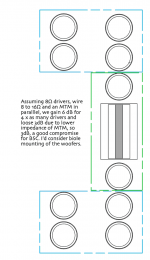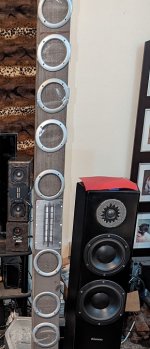Possibily an idea from left field.
12 drivers/array.
2+tweeter as an MTM, and then 8 or 10 as woofers to make a 3-way. Also potential to get things together in a way that allows a 2.5way.
dave
12 drivers/array.
2+tweeter as an MTM, and then 8 or 10 as woofers to make a 3-way. Also potential to get things together in a way that allows a 2.5way.
dave
4" spacing at 3k5 will likely present its nulls at 30 degrees left and right.
Don't automatically assume that this is a bad thing, but you should consider that the horizontal nature of this is inconsistent. A typical narrow direct radiating vertical line array is interesting because it has obvious horizontal room reflections but a significant reduction in verticals.
Don't automatically assume that this is a bad thing, but you should consider that the horizontal nature of this is inconsistent. A typical narrow direct radiating vertical line array is interesting because it has obvious horizontal room reflections but a significant reduction in verticals.
Ok,
At the risk of back-tracking, maybe I should return to my original idea of removing the 3" driver at ear-level, and mounting a tweeter (GRS 2522C-4 on order), to keep thing compact...
If I can use a 3kHz crossover and keep CTC spacing under 4" from tweeter, do you think the lobing would adversely affect the overall mid/treble response?
(Hope I'm not "whipping a dead horse"?)
Thanks
At the risk of back-tracking, maybe I should return to my original idea of removing the 3" driver at ear-level, and mounting a tweeter (GRS 2522C-4 on order), to keep thing compact...
If I can use a 3kHz crossover and keep CTC spacing under 4" from tweeter, do you think the lobing would adversely affect the overall mid/treble response?
(Hope I'm not "whipping a dead horse"?)
Thanks
There are numerous ways of looking at it. Another is that if you can accept the nulls and prevent the treble itself from going wide too, thus restoring consistency.
How short can we make the "tweeter line" , if we center it at ear-level with the listener (for instance I have enough 3.5" tweeters to put 4 in a line, which is about 14" long)?
The proposed crossover is around 3kHz with a third or fourth order crossover slope.
A line of eight PTmini-6's per side (let alone more) is still out of my budget at the moment.
Thanks
The proposed crossover is around 3kHz with a third or fourth order crossover slope.
A line of eight PTmini-6's per side (let alone more) is still out of my budget at the moment.
Thanks
Possibily an idea from left field.
12 drivers/array.
2+tweeter as an MTM, and then 8 or 10 as woofers to make a 3-way. Also potential to get things together in a way that allows a 2.5way.
dave
Hi Dave!
Not too far afield-
I've already stacked a few test enclosures, and tried a simple (coil & cap) crossover to hear the combo. Sounds really promising-I'm using a pair of these for my TV sound at the moment (Not much bass extension or loudness capability without more woofer surface area). I wonder how to integrate these together with an array, as you suggested? Also, I'd like to use a better crossover for improved performance & driver protection.
I hope to settle on a configuration that will provide good balance between sensitivity and frequency/polar response. Of course, the more dynamic and lower distortion, the better.
Thanks
Attachments
Last edited:
...2+tweeter as an MTM, and then 8 or 10 as woofers to make a 3-way. Also potential to get things together in a way that allows a 2.5way.
dave
Cool concept, although the clusters at top and bottom would be a challenge with my current baffles.
I've played with mocking up the MTM within a line format, as shown,but realize I need a to keep the baffle wider, and spacing as close as possible.
My current baffles are 60" tall by 6.5" wide,and I'm experimenting with chamfered/rounded edges to reduce edge diffraction.
I'm open to any idea, thanks.
Attachments
Not sure, but they are one wavelength away from it at around 250Hz,and they are supposed to have limited vertical dispersion...
Why do you ask?
Thanks.
Why do you ask?
Thanks.
Last edited by a moderator:
This is what you asked about before. You want to cross higher than that frequency or the 'limited vertical dispersion' means nothing.
Oh....
Sorry- I'm a bit confused. While I do get the part about crossing over above where problematic room reflections occur. But if the tweeter is supposed to "beam" in the vertical direction, and will be rolling off below 3kHz at 18dB/octave, why are we
so concerned with the ceiling, which is more than four feet away? Is it because it's the nearest highly reflective room surface?
Thanks.
Sorry- I'm a bit confused. While I do get the part about crossing over above where problematic room reflections occur. But if the tweeter is supposed to "beam" in the vertical direction, and will be rolling off below 3kHz at 18dB/octave, why are we
so concerned with the ceiling, which is more than four feet away? Is it because it's the nearest highly reflective room surface?
Thanks.
Last edited:
How short can we make the "tweeter line"
Reading this paper might help to answer that question: https://audioroundtable.com/misc/nflawp.pdf
You mention frequency, you must know that this does not work at low frequencies(?) The line array is much longer and is intended to beam if you make it the right way.But if the tweeter is supposed to "beam" in the vertical direction, and will be rolling off below 3kHz at 18dB/octave, why are we
so concerned with the ceiling,
2 threads on the same subject by the same OP merged.
Ah! Wondered why my partial response started in one of these threads returned an 'invalid link'/preview gone when I rebooted to finish/post it. 🙁
At what frequency will your tweeter hit the ceiling?
Read Griffin's paper (again).
Sorry, I'm afraid I still don't get your point about the tweeter hitting the ceiling...
Please explain.
Thanks ��
Last edited:
Allen, the tweeter reflection off the ceiling will not be near as significant given the limted vertical dispersion of the electrodynamic planar tweeter.
The question is more applicable to a dome.
dave
The question is more applicable to a dome.
dave
Are you familiar with reflections? Are you familiar with the purpose of the narrow dispersion?
Reflections are indirect sound that can help or harm the overall sound in the room. Narrow dispersion can be used to minimize unwanted reflections, right?
I'm here asking for help toward building better speakers.
.
Perhaps someone else has a helpful post to contribute (?)
Thanks.
- Home
- Loudspeakers
- Multi-Way
- Help Converting Line array into multi-way system?



